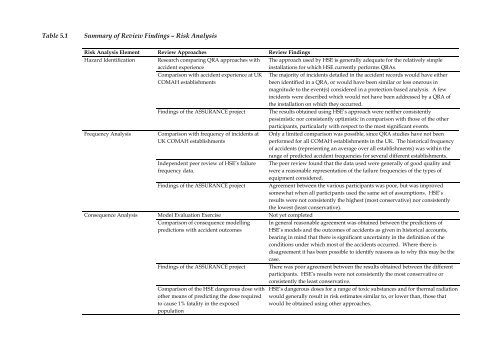A review of HSE's risk analysis and protection-based analysis ...
A review of HSE's risk analysis and protection-based analysis ...
A review of HSE's risk analysis and protection-based analysis ...
You also want an ePaper? Increase the reach of your titles
YUMPU automatically turns print PDFs into web optimized ePapers that Google loves.
Table 5.1 Summary <strong>of</strong> Review Findings – Risk Analysis<br />
Risk Analysis Element Review Approaches Review Findings<br />
Hazard Identification Research comparing QRA approaches with The approach used by HSE is generally adequate for the relatively simple<br />
accident experience<br />
installations for which HSE currently performs QRAs.<br />
Comparison with accident experience at UK The majority <strong>of</strong> incidents detailed in the accident records would have either<br />
COMAH establishments<br />
been identified in a QRA, or would have been similar or less onerous in<br />
magnitude to the event(s) considered in a <strong>protection</strong>-<strong>based</strong> <strong>analysis</strong>. A few<br />
incidents were described which would not have been addressed by a QRA <strong>of</strong><br />
the installation on which they occurred.<br />
Findings <strong>of</strong> the ASSURANCE project The results obtained using HSE’s approach were neither consistently<br />
pessimistic nor consistently optimistic in comparison with those <strong>of</strong> the other<br />
participants, particularly with respect to the most significant events.<br />
Frequency Analysis Comparison with frequency <strong>of</strong> incidents at Only a limited comparison was possible, since QRA studies have not been<br />
UK COMAH establishments<br />
performed for all COMAH establishments in the UK. The historical frequency<br />
<strong>of</strong> accidents (representing an average over all establishments) was within the<br />
range <strong>of</strong> predicted accident frequencies for several different establishments.<br />
Independent peer <strong>review</strong> <strong>of</strong> HSE’s failure The peer <strong>review</strong> found that the data used were generally <strong>of</strong> good quality <strong>and</strong><br />
frequency data.<br />
were a reasonable representation <strong>of</strong> the failure frequencies <strong>of</strong> the types <strong>of</strong><br />
equipment considered.<br />
Findings <strong>of</strong> the ASSURANCE project Agreement between the various participants was poor, but was improved<br />
somewhat when all participants used the same set <strong>of</strong> assumptions. HSE’s<br />
results were not consistently the highest (most conservative) nor consistently<br />
the lowest (least conservative).<br />
Consequence Analysis Model Evaluation Exercise Not yet completed<br />
Comparison <strong>of</strong> consequence modelling In general reasonable agreement was obtained between the predictions <strong>of</strong><br />
predictions with accident outcomes<br />
HSE’s models <strong>and</strong> the outcomes <strong>of</strong> accidents as given in historical accounts,<br />
bearing in mind that there is significant uncertainty in the definition <strong>of</strong> the<br />
conditions under which most <strong>of</strong> the accidents occurred. Where there is<br />
disagreement it has been possible to identify reasons as to why this may be the<br />
case.<br />
Findings <strong>of</strong> the ASSURANCE project There was poor agreement between the results obtained between the different<br />
participants. HSE’s results were not consistently the most conservative or<br />
consistently the least conservative.<br />
Comparison <strong>of</strong> the HSE dangerous dose with HSE’s dangerous doses for a range <strong>of</strong> toxic substances <strong>and</strong> for thermal radiation<br />
other means <strong>of</strong> predicting the dose required would generally result in <strong>risk</strong> estimates similar to, or lower than, those that<br />
to cause 1% fatality in the exposed<br />
population<br />
would be obtained using other approaches.

















